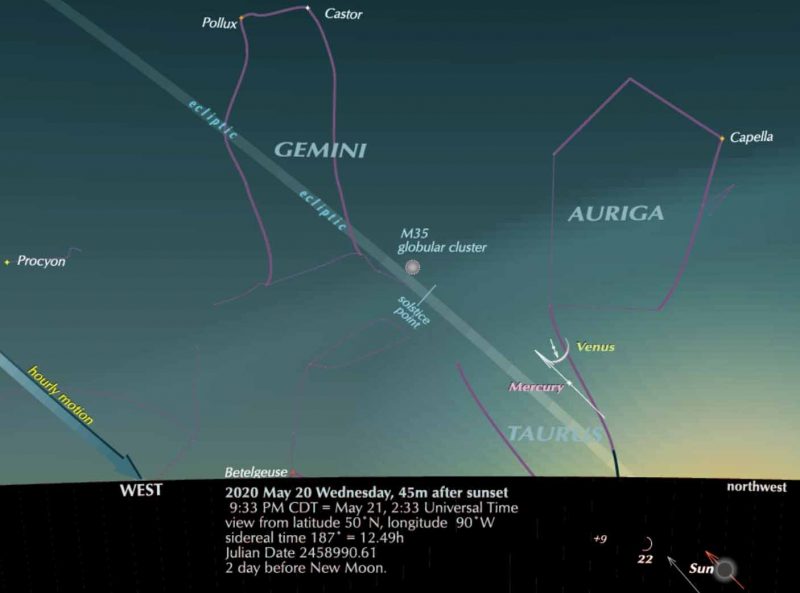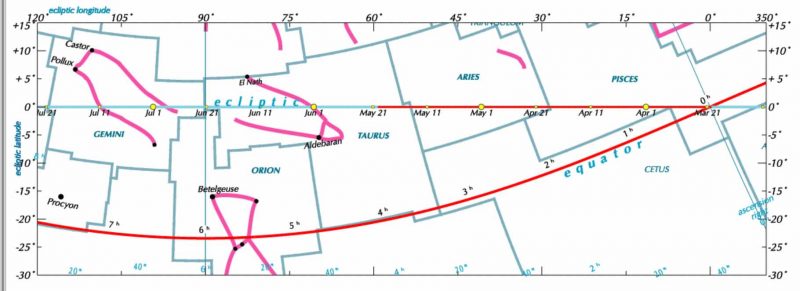

Here is the sun (below the horizon) at its May 20 position. On May 20, the sun enters the astrological “sign” of Gemini. Yet, as you can see from this chart, the actual constellation Gemini is still above the horizon when the sun is below it. The sun won’t enter the constellation Gemini until July. Chart via Guy Ottewell’s blog.
On Wednesday, May 20, the sun enters the astrological sign of Gemini. This gives us a rather good way of seeing the difference between astrological signs and the constellations as defined by astronomers.
The signs of Aries, Taurus, etc. – still used in astrology – are 30°-wide bands along the ecliptic, starting at longitude 0°, which is also known as the First Point of Aries. The constellations are areas of the starry sky, defined since 1930 by lines. The two coincided, somewhat more than 2,000 years ago, when the system of signs was defined. But precession – the wobbling of Earth’s spin axis over a cycle of 25,800 years – has made them increasingly divergent.
The chart below shows the sun’s travel from March 20 (the spring or vernal equinox) to May 20. You can see that the sun does indeed reach longitude 60° on the ecliptic. But this brings it to the beginning (roughly) of constellation Taurus, not Gemini. It will have to travel another 30° – two months – to enter Gemini.

View larger. | Chart showing the sun’s movement through the constellations, as defined by astronomers. You can see that sun won’t enter Gemini until July. Chart via Guy Ottewell’s blog.
The stars and constellations stay fixed. What shifts over time is the celestial equator – the “belt,” you could say, of the spinning Earth – and the mapping system based on it.
Mentally move them. Imagine the sun’s March-to-May track, and the celestial equator – the two features I’ve emphasized with red on the chart above – slid 30° to the left (east), while everything else stays in place. The crossing-point of equator and ecliptic – which is the zero point for longitude – is 30° to the left: it is at what is now longitude 30°, the beginning of Aries. So it really is then the First Point of Aries. In this mental projection, the sun is at the First Point of Aries in March, and arrives at the gates of Gemini at this time in May.
This was how things stood when the system of signs was agreed, around 2,000 years ago.
You can, with some imagination, see it in your sky, or on the chart at the top of this point.
There is the sun (below the horizon) at its May 20 position where it enters the astrological sign of Gemini. If this were 150 BC it would be 30° on, at what is now longitude 90° – the solstice point of our time, by the feet of Gemini.
With less need of imagination, and more of binocular aid, you can see Venus for one of the last times before it plunge into the glare of the sun. The arrows through the moving bodies indicate their motion over five days, against the starry background. So you can see that as the sun continues to advance in its usual way, Venus is falling back toward it.
And in the background Mercury is hurrying out toward its eastern elongation of June 4. So the two inner planets will have a conjunction on May 22, less than a degree apart. I hope I haven’t already made the joke about the planets failing to observe social distancing.
Bottom line: When – astrologically – the sun enters the “sign” of Gemini, it is still nearly two months away from entering the constellation Gemini in the sky.
from EarthSky https://ift.tt/2XijbZs


Here is the sun (below the horizon) at its May 20 position. On May 20, the sun enters the astrological “sign” of Gemini. Yet, as you can see from this chart, the actual constellation Gemini is still above the horizon when the sun is below it. The sun won’t enter the constellation Gemini until July. Chart via Guy Ottewell’s blog.
On Wednesday, May 20, the sun enters the astrological sign of Gemini. This gives us a rather good way of seeing the difference between astrological signs and the constellations as defined by astronomers.
The signs of Aries, Taurus, etc. – still used in astrology – are 30°-wide bands along the ecliptic, starting at longitude 0°, which is also known as the First Point of Aries. The constellations are areas of the starry sky, defined since 1930 by lines. The two coincided, somewhat more than 2,000 years ago, when the system of signs was defined. But precession – the wobbling of Earth’s spin axis over a cycle of 25,800 years – has made them increasingly divergent.
The chart below shows the sun’s travel from March 20 (the spring or vernal equinox) to May 20. You can see that the sun does indeed reach longitude 60° on the ecliptic. But this brings it to the beginning (roughly) of constellation Taurus, not Gemini. It will have to travel another 30° – two months – to enter Gemini.

View larger. | Chart showing the sun’s movement through the constellations, as defined by astronomers. You can see that sun won’t enter Gemini until July. Chart via Guy Ottewell’s blog.
The stars and constellations stay fixed. What shifts over time is the celestial equator – the “belt,” you could say, of the spinning Earth – and the mapping system based on it.
Mentally move them. Imagine the sun’s March-to-May track, and the celestial equator – the two features I’ve emphasized with red on the chart above – slid 30° to the left (east), while everything else stays in place. The crossing-point of equator and ecliptic – which is the zero point for longitude – is 30° to the left: it is at what is now longitude 30°, the beginning of Aries. So it really is then the First Point of Aries. In this mental projection, the sun is at the First Point of Aries in March, and arrives at the gates of Gemini at this time in May.
This was how things stood when the system of signs was agreed, around 2,000 years ago.
You can, with some imagination, see it in your sky, or on the chart at the top of this point.
There is the sun (below the horizon) at its May 20 position where it enters the astrological sign of Gemini. If this were 150 BC it would be 30° on, at what is now longitude 90° – the solstice point of our time, by the feet of Gemini.
With less need of imagination, and more of binocular aid, you can see Venus for one of the last times before it plunge into the glare of the sun. The arrows through the moving bodies indicate their motion over five days, against the starry background. So you can see that as the sun continues to advance in its usual way, Venus is falling back toward it.
And in the background Mercury is hurrying out toward its eastern elongation of June 4. So the two inner planets will have a conjunction on May 22, less than a degree apart. I hope I haven’t already made the joke about the planets failing to observe social distancing.
Bottom line: When – astrologically – the sun enters the “sign” of Gemini, it is still nearly two months away from entering the constellation Gemini in the sky.
from EarthSky https://ift.tt/2XijbZs

Aucun commentaire:
Enregistrer un commentaire